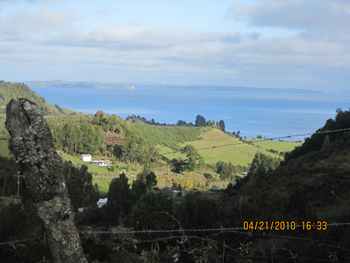Stepping back in time: Chiloe Island

Sowell Family's Travels on Gijima
Skipper: Tim Sowell Admiral Tracy Crew Sean & Alex
Fri 21 May 2010 13:22
a common problem in Chile (each time we have hired a car) a lack of maps are
available or even provided, maybe we use to USA which you get a map, or we
have a GPS. So we headed out with a photo copy of a town tourist map, and
headed to the second largest island in Chile "Isla Chiloe".
Chiloe is about 180km long at 50 km wide, and really was only merged into
the greater Chile in 1960 after an earthquake. This is where the said
"original Chilean people" came from, and they are meant to have their own
culture and exocentric way. The main island is surrounded on the inside by
an archipelago of islands which have been inhabited and each has their own
distinct culture. Everyone told it is must to do, and as explained yesterday
we had trouble with tours so we have our own car, lonely planet chapter for
this Island and sort of map.
We crossed on a large car ferry it was about a 20 minute ride on a system of
couple of these big ferries that just go back and forth from the island to
mainland, loaded with cars, buses and lorries.
The first thing I noticed as we went along the narrow main rod of the island
through the country side was the old stainless steel pales of milk at the
drive ways of the farms and road, (I had not seen these in 30 years) and
then we caught up to a truck collecting and delivering these pales of milk.
Driving through the center of the island to the main town of Castro (90km
down the island) with the mist and vegetation I could have been mistaken
that I was in New Zealand or Cornwell on a narrow road with trucks, no room
to pass, and unable to see ahead.
On arriving at Castro we were in time for the May 21st(tomorrow is a
holiday) pre parade that caused traffic jams, but as we had seen all the way
down, brightly colored wooden shingled homes lined the water on stilts in
many states of repair (see photo). What the island is famous for is the huge
amount of wooden churches. After a so / so lunch we then took some back
roads around the country swapping between sealed and dirt roads, we followed
the coast running into small towns, but no matter how small/ big (could be 3
houses) they had a wooden church with it's own character. When you enter the
whole thing is wooden even though some look like cathedrals with towers they
are all made out of local wood. The sun had broken through, and the site was
superb (very Kiwi like around the bay of Islands) the green rolling hills
and steep decent to the coast, the coast full of oyster farms out in the
bays, which there are many, and the colorful houses (very none Kiwi) and
brightly colorful fishing boats all resting on the mud flats. Just off the
coast were islands small, and some bigger with houses boats and ferries
madly going back and forth.
You can see from the photos the range of some of churches we past. Certainly
for us the country side and small towns / groupings of houses had more
appeal than the main town of Castro, the farming is all dairy, sheep and
cattle, and they are independent.
On the way home we were against the clock for the car hire closing for the
holiday and bad maps and sure enough we discovered a lot more of Puerto
Montt than we wanted to, we followed signs and were off pour maps fast, but
we made it through the maze of one ways and end of week traffic to be back
with 2 minutes spare.







